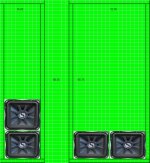Hi there. From experience house, dub-step and modern pop music are very very bass-intensive! Therefore horn-loaded designs are NOT the answer. The best way is to sacrifice some extreme SPL and go for smoother extended low-bass response that a properly tuned bass-reflex cabinet will give you. Remember to set the limiter to ON and low-frequency cut-off on your amps to 40Hz otherwise the reflex box tuning becomes unloaded below the box frequency resulting in destroyed drivers. I use 8x 1x18" in my rig (with a Fco of 40Hz) and have not yet blown a driver despite feeding them twice their rated power. Regards, the SoundMan
Well, that's certainly one opinion. My opinion is that horns can be tuned just as low as ported boxes. You trade size for sensitivity.
In this case it's unclear which the OP values more because he didn't give a list of goals. IMO, since he's playing the system out in a field, the power requirements (sensitivity) trumps any benefit of ported boxes.
Anyway, 40 hz tuning is very high for modern music, I'd much prefer 30 or lower.
In this case it's unclear which the OP values more because he didn't give a list of goals. IMO, since he's playing the system out in a field, the power requirements (sensitivity) trumps any benefit of ported boxes.
Anyway, 40 hz tuning is very high for modern music, I'd much prefer 30 or lower.
Hi there. From experience house, dub-step and modern pop music are very very bass-intensive! Therefore horn-loaded designs are NOT the answer. The best way is to sacrifice some extreme SPL and go for smoother extended low-bass response that a properly tuned bass-reflex cabinet will give you. Remember to set the limiter to ON and low-frequency cut-off on your amps to 40Hz otherwise the reflex box tuning becomes unloaded below the box frequency resulting in destroyed drivers. I use 8x 1x18" in my rig (with a Fco of 40Hz) and have not yet blown a driver despite feeding them twice their rated power. Regards, the SoundMan
Your first sentence and the 40hz comment don't really add up. There are plenty of designs which get LOUD to 40hz, but not much at all below.
Yes, there are also the pay-for BFM designs, but this forum is full of plenty of examples tapped horns that also fit that bill. Assuming a 40Hz low-cut filter is being used on the processor or amplifier, then http://www.diyaudio.com/forums/subwoofers/232219-325-lab-12-based-pa-tapped-horn-35hz-extension.html seems to work just fine.
I just arranged a party for 200 people in a 300 m2 wooden cabin using a single 1850 horn with PD1850 and EV top end (horn curve bent out of 2mm sheet metal without sharp angles) and according to the REW measurement it went flat to 25hz (from where it was cut 48db/oct) when boosted +8db on the bottom. A single cabinet gave so much sound pressure using a Behringer EP2500 in bridged mono (around 2kW) that we had to drop the volume to around 50% due to dancers requests.
The cabinet gives extremely tight and punchy bass and made the floor physically vibrate. So yeah, I consider the project extremely good and contrary to some claims it can easily do 25hz or even 20hz if corrected. I have pushed the box as hard as possible but it never seems to break a sweat. It just makes things shake.
The cabinet gives extremely tight and punchy bass and made the floor physically vibrate. So yeah, I consider the project extremely good and contrary to some claims it can easily do 25hz or even 20hz if corrected. I have pushed the box as hard as possible but it never seems to break a sweat. It just makes things shake.
Below the horn cut off frequency, the drivers perform like a sealed box. Although the box (and room) may have been "easily" equalized flat to 25 Hz using 8 dB boost (about 6 times the power..), the level produced down that low could have been achieved with the same drivers in boxes the size of the small compression chamber of the 1850 FLH.I just arranged a party for 200 people in a 300 m2 wooden cabin using a single 1850 horn with PD1850 and EV top end (horn curve bent out of 2mm sheet metal without sharp angles) and according to the REW measurement it went flat to 25hz (from where it was cut 48db/oct) when boosted +8db on the bottom.
So yeah, I consider the project extremely good and contrary to some claims it can easily do 25hz or even 20hz if corrected.
What is your point? The fact is that the box is capable of extension with correction and the qualities of the horn do not disappear anywhere. The project is good and worthwhile building.Below the horn cut off frequency, the drivers perform like a sealed box. Although the box (and room) may have been "easily" equalized flat to 25 Hz using 8 dB boost (about 6 times the power..), the level produced down that low could have been achieved with the same drivers in boxes the size of the small compression chamber of the 1850 FLH.
The point is just that room gain and extension with correction have nothing to do with the "qualities of the horn" below it's cutoff frequency (Fc) of around 50 Hz.What is your point? The fact is that the box is capable of extension with correction and the qualities of the horn do not disappear anywhere. The project is good and worthwhile building.
Unless you prefer the sound of harmonic distortion, what is the point of building a 50Hz horn and driving it with an 8 dB boost an octave below Fc?
Agreed. You should have horn loading down to the desired Fc. Bass boost should not be required for a desired Fc.
- Status
- Not open for further replies.
- Home
- Loudspeakers
- Subwoofers
- Difference Between 1850 and 186 FOLDED HORN!!!!
